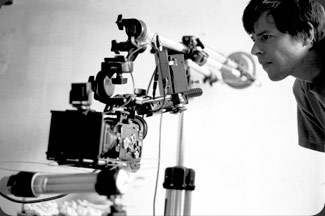 |
"Low-budget crew devises Super-duper stock and gear"
by Mark Dillon Playback July 22, 2002 (page 12)
When a production can't afford to rent the equipment it wants, one solution is to muster all one's technical ingenuity to modify the gear it already has, or come up with some altogether new gizmos. This kind of resourcefullness was put into action on Sleep Always, a low-budget feature from prodco Friendly Fire that wrapped recently in Toronto. The film also exemplifies the continuing love affair with small-gauge motion picture stocks in the face of digital video's increasing popularity.
The movie, a drama about a delusional man's obsessive love for a street woman, was shot in the crew's invented "super-duper-8" format, a letterbox version of Super 8 that exposes a greater area of the frame, including the part where the sound strip lies, like in Super 16. (Audio was recorded on a Nagra.) The filmmakers opted for this format instead of higher-end 16mm, which would have delayed the commencement of shooting while they gathered the required funding.
The film was a labour of love for cowriters and codirectors Mitch Perkins and Rick Palidwor, who shot on-and-off over several months. Perkins, a former drummer who has directed or lensed several spots and videos, functioned as director of photography, while Palidwor, a researcher, comedy writer and director of numerous short films, produced.
Perkins removed the gate from his Super 8 camera, filed it down so that it was 13% wider for maximum exposure area, then reinstalled it. He shot with Kodak Ektachrome 7240 reversal stock, achieving the best results when underexposing a full stop. Toronto's Exclusive Film & Video, conveniently located in the same building where Perkins rents a studio and where the film was mostly shot, handled processing.
In the telecine process, the wide frame was shrunk approximately 30% to fit the 4:3 TV ratio, which tightened the grain and provided a sharper picture than normal Super 8. Perkins performed the film transfer with a projector he modified by removing the projector gate for utmost framing flexibility. He transferred a 4:3 image masked to 1.85:1 to avoid showing the edges of the adjacent frames.
The crew used a Nikon R-10 camera with a 7-70mm lens, which shoots slow motion at 54 frames per second and allows for fades and dissolves in-camera - they preferred this look to similar effects done in digital post. Perkins constructed a new base-plate and a metal frame which wrapped around the entire camera, to which various accessories could be attached, including additional lenses (one from an overhead projector), bellows, matte boxes, lights and a homemade video assist. The latter piece of gear consisted of a pinhole camera mounted above the lens and wired into a small, battery-run LCD screen. Multiple tripods formed boom arms.
Since principal cast members Fred Spek and Laurie Maher were making their screen debuts and were new to the tecnical aspects of continuity, the directors opted for two-camera coverage in certain dialogue-heavy scenes. The 'B' camera was a Canon 814 XLS, which Palidwor also used to pick up final shots from one set as Prekins would set up the next. A Nizo S560 camera, which offers frame rates of one frame per minute to 54 frames per second and allows for the shutter to be locked open, was used to create unusual motion effects simulating the main character's delusional attacks. For an even more pronounced effect, the crew used a hand-run time-exposure camera Perkins put together from a broken camera Palidwor had lying around. This camera's wildly variable frame rate resulted in manic, pulsing images.
Natural Light
The crew used natural lighting in some sequences and practicals topped up with a couple of 650W Super 8 lights, 500W photofloods and a Lowel lighting kit in others. Palidwor admits he and his partner wished they had used more artificial light sources in some shots.
Palidwor estimates the budget of Sleep Always, deferrals included, at $500,000, with the cash actually spent far lower. Aside from a couple of private investors, the Liaison of Independent Filmmakers of Toronto contributed $1,000.
In explaining why the production opted for the old-school Super 8 format over the economical and popular DV, Perkins offers, "Texture and latitude are obvious differences, but an overlooked consideration is the greater versatility of the film camera itself."
Adding some professional sheen to the production is its audio mix. It helped that Perkins' brother Jeffrey is a re-recording mixer at International Recording in Burbank, CA and an Oscar-winner for Dances with Wolves. Jeffrey volunteered to do the mix and was able to bring on board the services of Toronto audio/picture post shop Tattersall Casablanca.
The filmmakers are currently submitting Sleep Always to various festivals in its finished DigiBeta version. The Digital Film Group in Vancouver is performing a test to see how the film would look when transferred from tape to 35mm.
Copyright ©2002 Friendly Fire Films, All Rights Reserved.

